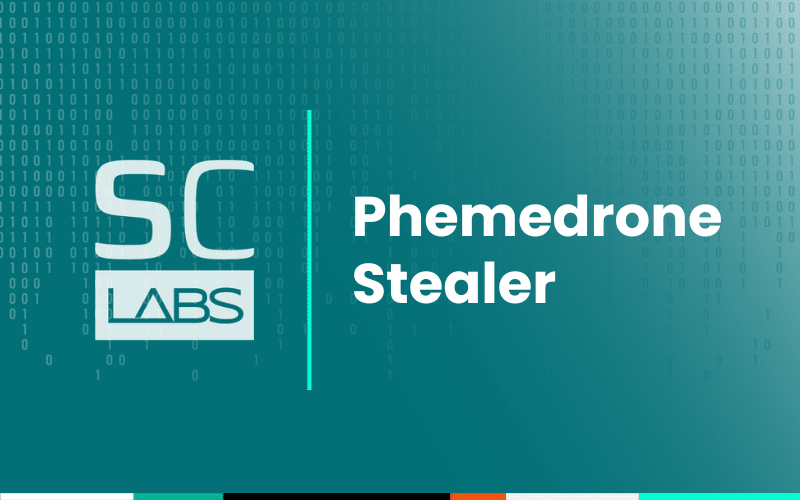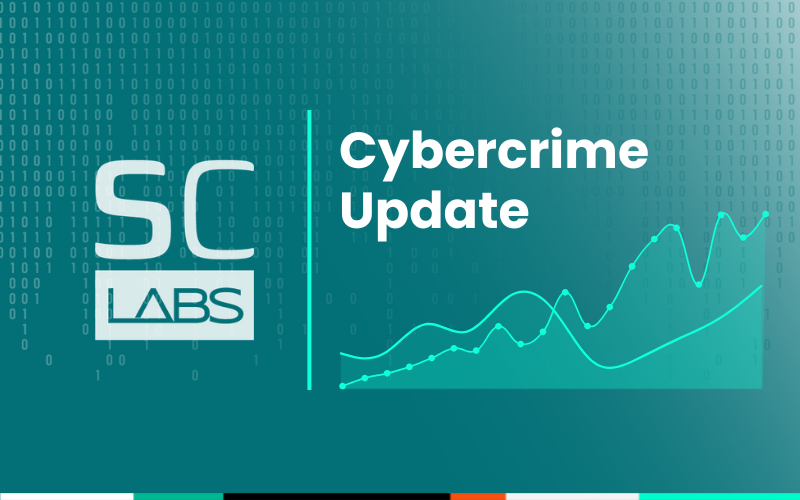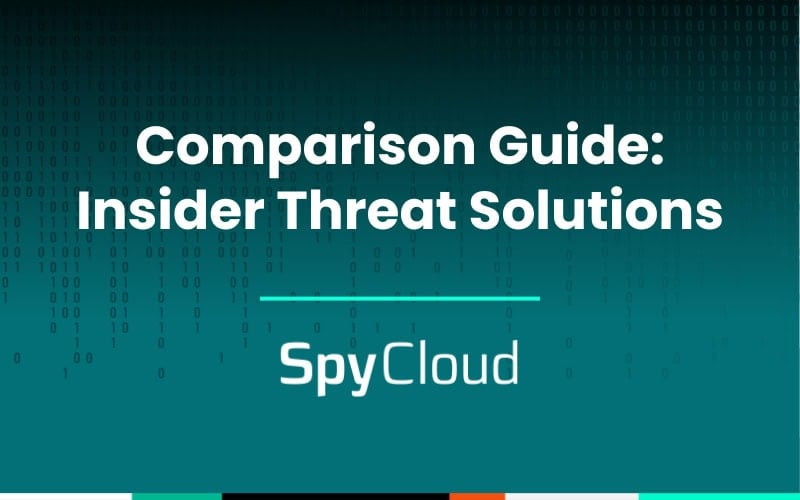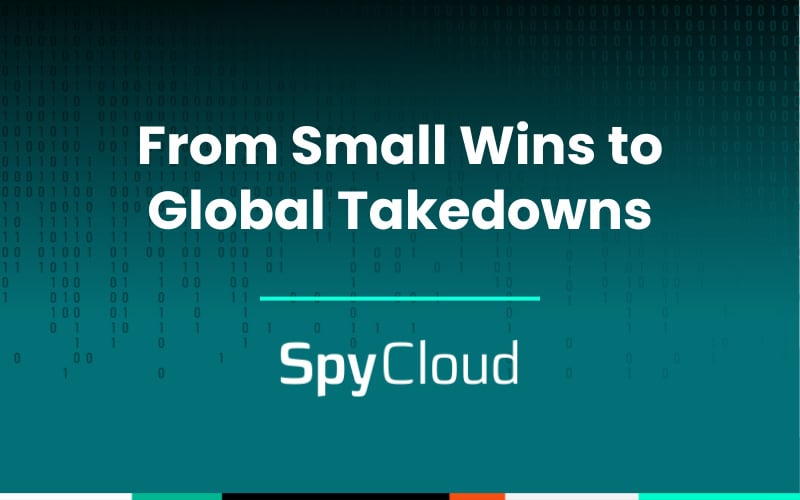At SpyCloud, we recapture logs from more than sixty infostealer malware families, but very few of them are open source stealers. Intrigued, our team at SpyCloud Labs took on the task of dissecting Phemedrone, an open source stealer available to anyone on Telegram.
When we dug in, we found Phemedrone to have some other unique characteristics as well, namely:
- Its ability to encrypt logs with RSA + AES
- A high-level of configurability
- Apparent targeting of Russian users/services
Here’s what we found.
About Phemedrone Stealer
Phemedrone, which as we mentioned is an entirely open source stealer, is written in C# and therefore provides abundant opportunities for actors to customize the malware to suit their needs. It also gives bad actors an easy snapshot of what they have stolen within its logs, leveraging password/cookie “tagging” for various categories. However, when looking at the definitions for these tags, it becomes clear that many of these tags focus on Russian targets, which is pretty unique for a stealer.
Phemedrone’s offering
With code distributed mainly over Telegram (and previously on GitHub before being taken down), bad actors can acquire and deploy Phemedrone for free. Phemedrone offers log encryption when sending to Telegram, browser/application theft, cookie tagging, and more, as well as the ability to easily tweak the stealer in C#.
Phemedrone’s devs release regular updates for both their panel as well as their builder, which keeps Phemedrone active and well-used. They also offer a chat for people to discuss Phemedrone.
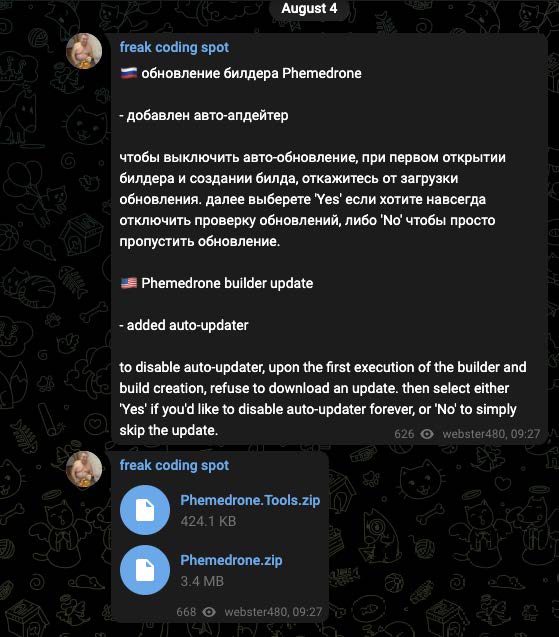
Image 1: Phemedrone’s chat offering, in both English and Russian.
Binary analysis
Phemedrone’s operation is fairly simple, opting to do password/cookie parsing on the victim’s machine instead of just stealing entire raw password database files to be parsed on a panel later. This allows Phemedrone to then tag stolen passwords and cookies with a variety of categories to make it easy to identify which logs are useful. By default, many of these tag values are associated with primarily Russian targets, such as tinkoff and sberbank for “BANK”.
Stealer capabilities
Browser theft
| Extension name | Extension GUID |
| Authenticator | bhghoamapcdpbohphigoooaddinpkbai |
| EOS Authenticator | oeljdldpnmdbchonielidgobddffflal |
| BrowserPass | naepdomgkenhinolocfifgehidddafch |
| MYKI | bmikpgodpkclnkgmnpphehdgcimmided |
| Splikity | jhfjfclepacoldmjmkmdlmganfaalklb |
| CommonKey | chgfefjpcobfbnpmiokfjjaglahmnded |
| Zoho Vault | igkpcodhieompeloncfnbekccinhapdb |
| Norton Password Manager | admmjipmmciaobhojoghlmleefbicajg |
| Avira Password Manager | caljgklbbfbcjjanaijlacgncafpegll |
| Trezor Password Manager | imloifkgjagghnncjkhggdhalmcnfklk |
| MetaMask | nkbihfbeogaeaoehlefnkodbefgpgknn |
| TronLink | ibnejdfjmmkpcnlpebklmnkoeoihofec |
| BinanceChain | fhbohimaelbohpjbbldcngcnapndodjp |
| Coin98 | aeachknmefphepccionboohckonoeemg |
| iWallet | kncchdigobghenbbaddojjnnaogfppfj |
| Wombat | amkmjjmmflddogmhpjloimipbofnfjih |
| NeoLine | cphhlgmgameodnhkjdmkpanlelnlohao |
| Terra Station | aiifbnbfobpmeekipheeijimdpnlpgpp |
| Keplr | dmkamcknogkgcdfhhbddcghachkejeap |
| Sollet | fhmfendgdocmcbmfikdcogofphimnkno |
| ICONex | flpiciilemghbmfalicajoolhkkenfel |
| KHC | hcflpincpppdclinealmandijcmnkbgn |
| TezBox | mnfifefkajgofkcjkemidiaecocnkjeh |
| Byone | nlgbhdfgdhgbiamfdfmbikcdghidoadd |
| OneKey | ilbbpajmiplgpehdikmejfemfklpkmke |
| Trust Wallets | pknlccmneadmjbkollckpblgaaabameg |
| MetaWallet | pfknkoocfefiocadajpngdknmkjgakdg |
| Guarda Wallet | fcglfhcjfpkgdppjbglknafgfffkelnm |
| Exodus | idkppnahnmmggbmfkjhiakkbkdpnmnon |
| JaxxxLiberty | mhonjhhcgphdphdjcdoeodfdliikapmj |
| Atomic Wallet | bhmlbgebokamljgnceonbncdofmmkedg |
| Electrum | hieplnfojfccegoloniefimmbfjdgcgp |
| Mycelium | pidhddgciaponoajdngciiemcflpnnbg |
| Coinomi | blbpgcogcoohhngdjafgpoagcilicpjh |
| GreenAddress | gflpckpfdgcagnbdfafmibcmkadnlhpj |
| Edge | doljkehcfhidippihgakcihcmnknlphh |
| BRD | nbokbjkelpmlgflobbohapifnnenbjlh |
| Samourai Wallet | apjdnokplgcjkejimjdfjnhmjlbpgkdi |
| Copay | ieedgmmkpkbiblijbbldefkomatsuahh |
| Bread | jifanbgejlbcmhbbdbnfbfnlmbomjedj |
| KeepKey | dojmlmceifkfgkgeejemfciibjehhdcl |
| Trezor | jpxupxjxheguvfyhfhahqvxvyqthiryh |
| Ledger Live | pfkcfdjnlfjcmkjnhcbfhfkkoflnhjln |
| Ledger Wallet | hbpfjlflhnmkddbjdchbbifhllgmmhnm |
| Bitbox | ocmfilhakdbncmojmlbagpkjfbmeinbd |
| Digital Bitbox | dbhklojmlkgmpihhdooibnmidfpeaing |
| YubiKey | mammpjaaoinfelloncbbpomjcihbkmmc |
| Google Authenticator | khcodhlfkpmhibicdjjblnkgimdepgnd |
| Microsoft Authenticator | bfbdnbpibgndpjfhonkflpkijfapmomn |
| Authy | gjffdbjndmcafeoehgdldobgjmlepcal |
| Duo Mobile | eidlicjlkaiefdbgmdepmmicpbggmhoj |
| OTP Auth | bobfejfdlhnabgglompioclndjejolch |
| FreeOTP | elokfmmmjbadpgdjmgglocapdckdcpkn |
| Aegis Authenticator | ppdjlkfkedmidmclhakfncpfdmdgmjpm |
| LastPass Authenticator | cfoajccjibkjhbdjnpkbananbejpkkjb |
| Dashlane | flikjlpgnpcjdienoojmgliechmmheek |
| Keeper | gofhklgdnbnpcdigdgkgfobhhghjmmkj |
| RoboForm | hppmchachflomkejbhofobganapojjol |
| KeePass | lbfeahdfdkibininjgejjgpdafeopflb |
| KeePassXC | kgeohlebpjgcfiidfhhdlnnkhefajmca |
| Bitwarden | inljaljiffkdgmlndjkdiepghpolcpki |
| NordPass | njgnlkhcjgmjfnfahdmfkalpjcneebpl |
| LastPass | gabedfkgnbglfbnplfpjddgfnbibkmbb |
| Nifty Wallet | jbdaocneiiinmjbjlgalhcelgbejmnid |
| Math Wallet | afbcbjpbpfadlkmhmclhkeeodmamcflc |
| Coinbase Wallet | hnfanknocfeofbddgcijnmhnfnkdnaad |
| Equal Wallet | blnieiiffboillknjnepogjhkgnoac |
| EVER Wallet | cgeeodpfagjceefieflmdfphplkenlfk |
| Jaxx Liberty | ocefimbphcgjaahbclemolcmkeanoagc |
| BitApp Wallet | fihkakfobkmkjojpchpfgcmhfjnmnfpi |
| Mew CX | nlbmnnijcnlegkjjpcfjclmcfggfefdm |
| GU Wallet | nfinomegcaccbhchhgflladpfbajihdf |
| Guild Wallet | nanjmdkhkinifnkgdeggcnhdaammmj |
| Saturn Wallet | nkddgncdjgifcddamgcmfnlhccnimig |
| Harmony Wallet | fnnegphlobjdpkhecapkijjdkgcjhkib |
| TON Wallet | nphplpgoakhhjchkkhmiggakijnkhfnd |
| OpenMask Wallet | penjlddjkjgpnkllboccdgccekpkcbin |
| MyTonWallet | fldfpgipfncgndfolcbkdeeknbbbnhcc |
| DeWallet | pnccjgokhbnggghddhahcnaopgeipafg |
| TrustWallet | egjidjbpglichdcondbcbdnbeeppgdph |
| NC Wallet | imlcamfeniaidioeflifonfjeeppblda |
| Moso Wallet | ajkifnllfhikkjbjopkhmjoieikeihjb |
| Enkrypt Wallet | kkpllkodjeloidieedojogacfhpaihoh |
| CirusWeb3 Wallet | kgdijkcfiglijhaglibaidbipiejjfdp |
| Martian and Sui Wallet | efbglgofoippbgcjepnhiblaibcnclgk |
| SubWallet | onhogfjeacnfoofkfgppdlbmlmnplgbn |
| Pontem Wallet | phkbamefinggmakgklpkljjmgibohnba |
| Talisman Wallet | fijngjgcjhjmmpcmkeiomlglpeiijkld |
| Kardiachain Wallet | pdadjkfkgcafgbceimcpbkalnfnepbnk |
| Phantom Wallet | bfnaelmomeimhIpmgjnjophhpkkoljpa |
| Oxygen Wallet | fhilaheimglignddjgofkcbgekhenbh |
| PaliWallet | mgfffbidihjpoaomajlbgchddlicgpn |
| BoltX Wallet | aodkkagnadcbobfpggnjeongemjbjca |
| Liquality Wallet | kpopkelmapcoipemfendmdghnegimn |
| xDefi Wallet | hmeobnffcmdkdcmlb1gagmfpfboieaf |
| Nami Wallet | Ipfcbjknijpeeillifnkikgncikgfhdo |
| MaiarDeFi Wallet | dngmlblcodfobpdpecaadgfbeggfjfnm |
| MetaMask Edge Wallet | ejbalbakoplchlghecdalmeeeajnimhm |
| Goblin Wallet | mlbafbjadjidk1bhgopoamemfibcpdfi |
| Braavos Smart Wallet | jnlgamecbpmbajjfhmmmlhejkemejdma |
| UniSat Wallet | ppbibelpcjmhbdihakflkdcoccbgbkpo |
| OKX Wallet | mcohilncbfahbmgdjkbpemcciiolgcge |
| Manta Wallet | enabgbdfcbaehmbigakijjabdpdnimlg |
| Suku Wallet | fopmedgnkfpebgllppeddmmochcookhc |
| Suiet Wallet | khpkpbbcccdmmclmpigdgddabeilkdpd |
| Koala Wallet | lnnnmfcpbkafcpgdilckhmhbkkbpkmid |
| ExodusWeb3 Wallet | aholpfdialjgjfhomihkjbmgjidlcdno |
| Aurox Wallet | kilnpioakcdndlodeeceffgjdpojajlo |
| Fewcha Move Wallet | ebfidpplhabeedpnhjnobghokpiioolj |
| Carax Demon Wallet | mdjmfdffdcmnoblignmgpommbefadffd |
| Leap Terra Wallet | aijcbedoijmgnlmjeegjaglmepbmpkpi |
Cryptowallet theft
Phemedrone also targets cryptowallets on the victim’s machine, looking for “wallet.dat” files to steal from. Additionally, Phemedrone steals from the following hardcoded cryptowallets:
- Armory
- Atomic
- Bytecoin
- Coninomi
- Jaxx
- Electrum
- Exodus
- Guarda
- ZCash
This functionality allows Phemedrone to steal victims’ cryptocurrency with ease.
Discord token theft
Phemedrone will target Discord tokens by accessing the Discord leveldb database, stored on a victim’s computer. It will then regex for “dQw4w9WgXcQdQw4w9WgXcQ:[^\”]*”, which it will use to extract the victim’s Discord token for authentication purposes. This string is appended to each encrypted Discord token stored in the victim’s Discord leveldb database. The exact string is actually a rickroll easter egg.
FileGrabber
Phemedrone also includes a basic filegrabber, which will iterate through My Documents and Desktop and steal all files based on config supplied max file size and directory depth.
FTP theft
Phemedrone will target a popular FTP application, FileZilla, for theft. From FileZilla, Phemedrone will steal a victim’s “recentservers.xml” as well as their “sitemanager.xml”
Screenshot
Phemedrone will automatically obtain a screenshot of the victim’s screen post installation for exfiltration.
Steam theft
Phemedrone will target the game application Steam for theft, stealing *ssfn* and \\config.vdf files, which attackers can use to take over a victim’s Steam account.
Telegram theft
Phemedrone targets Telegram for theft, too. Phemedrone grabs the DefaultIcon from a victim’s registry, in addition to stealing a victim’s tdata information, which can be used to take over their Telegram account.
VPN theft
Phemedrone targets several common VPN providers for theft in order to steal a victim’s VPN connection info. Phemedrone targets the following applications:
- OpenVPN: Steals Profiles and ovpn files
- ProtonVPN: Steals ProtonVPN user.config
- SurfShark: Steals SurfShark *.dat
Cookie and password tagging
Phemedrone has the ability to look through stolen cookies/passwords and provide a “snapshot” of what was stolen using a list of tags contained in the binary. These tags look for domains and are as follows:
| Tag Category | Tag Domain |
| Cheats | celka. |
| Cheats | nursultan. |
| Cheats | xone |
| Cheats | akrien |
| Cheats | interium |
| Cheats | nixware |
| Cheats | skeet |
| Games | roblox.com. |
| Games | genshin |
| Games | minecraft.net |
| Games | epicgames.com |
| Games | steampowered.com |
| Bank | tinkoff |
| Bank | sberbank |
| Money | yoomoney |
| Money | amazon |
| Money | funpay |
| Money | americanexpress |
| Crypto | binance |
| Crypto | bybit |
These tags are added to the generated Information.txt, along with information about the victim’s system, total passwords stolen, total cookies stolen, and an ASCII heart with the Phemedrone author signature. These tags are easily customizable, and in fact, in variants such as “Mephedrone”, we can see tags added to the list, such as “FACEBOOK”.

Image 2: The Phemedrone Stealer author tag added to the top of logs.
As observed in the above table, in the BANK section, both of the domains are for banks commonly used in Russia. Additionally, in the MONEY section, half (yoomoney, funpay) are services commonly used in Russia. As will be discussed in later sections, while this malware does have a CIS check in the binary, this check is an optional toggle switch during the creation of a bot and can easily be toggled off, allowing Phemedrone to target areas where the MONEY/BANK sections could be used to their fullest.
Useragent generation
As observed in the screenshot below, Phemedrone has the ability to generate random useragents, which it uses during communication with its C2. This possibly helps it sneak by detections that might rely on hardcoded useragent values.
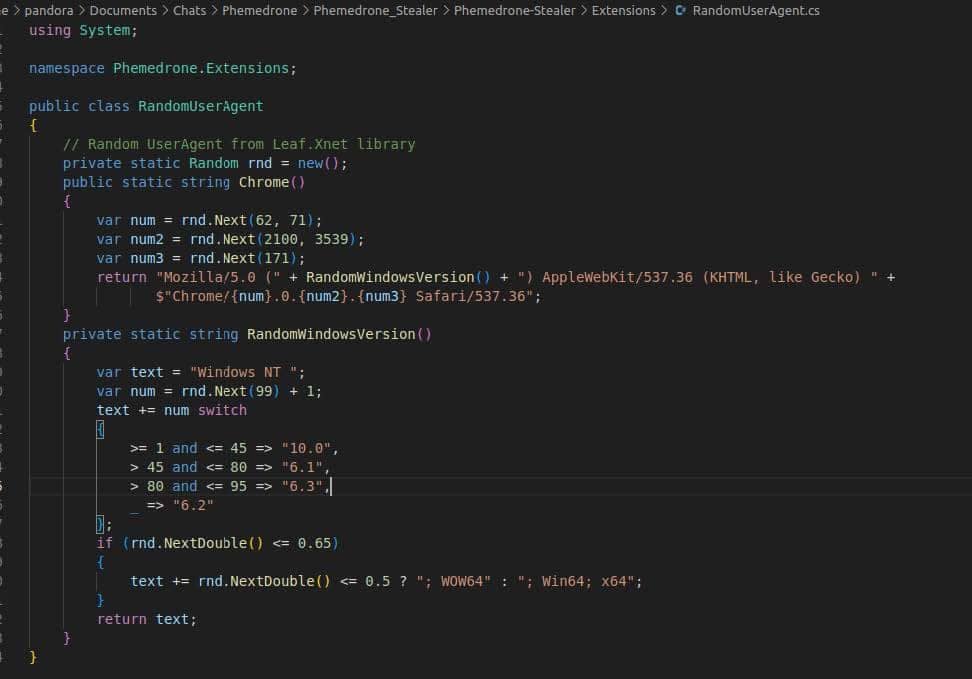
Image 3: Code from Phemedrone which shows how it can easily change its useragent on the fly.
Anti-analysis checks
Phemedrone contains several anti-analysis checks which can be enabled during the build phase of the malware. If any of the checks described below are successful, Phemedrone exits.
Anti-debugger
Phemedrone’s anti-debugger check checks the victim’s environment for the following processes, which may indicate that Phemedrone is being debugged:
- “wireshark”
- “httpdebuggerui”
- “mtmproxy”
- “sniffer”
Anti-VM
Phemedrone’s anti-VM check checks the victim’s computer for the following virtual machine (VM) strings, which indicate that Phemedrone is being run in a VM:
- VirtualBox
- VBox
- VMware Virtual
- VMware
- Hyper-V Video
- Microsoft
CIS check
Phemedrone has a check that checks if a victim is a speaker of the following languages spoken in Commonwealth of Independent States (CIS) countries, by using a keyboard language check, as observed in Image 4:
- Russian
- Kazakh
- Moldovan
- Uzbek
- Belarusian
- Azerbaijani
- Armenian
- Kyrgyz
- Tajik
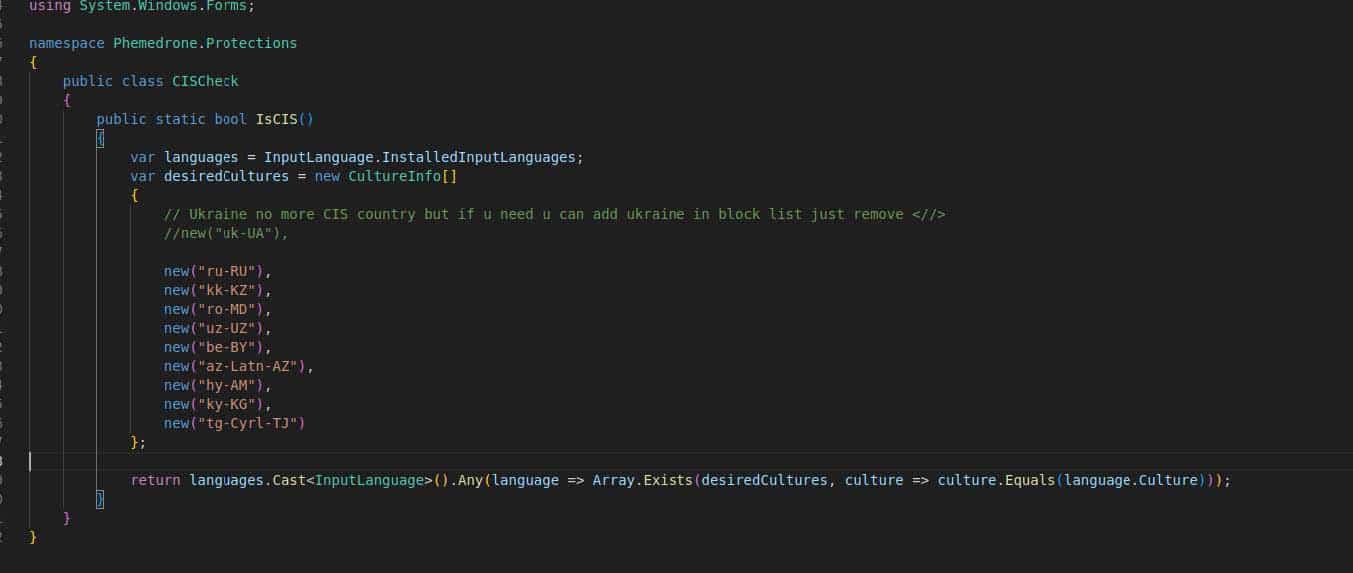
Image 4: This is an optional check in the build process for a bot and is disabled by default.
Mutex check
Using the hardcoded config, Phemedrone checks to see if it is already running by checking to see if its mutex already exists.
Senders
Phemedrone’s bot builder has three different “sender” customization options, with some of the options behaving differently than the others. The three options are as follows:
- Gate - Sends logs to a php gate
- Panel - Sends logs to an IP/PORTcombo
- Telegram - Sends logs to a telegram channel
Gate sender
Phemedrone’s gate sender allows actors using Phemedrone to specify a C2 that hosts the Phemedrone gate.php script. Bots that connect to this php gate will send their logs there, and then:
- Logs that are larger than 52MB will be stored on the server, and
- Logs that are smaller than 52MB will be uploaded directly to Telegram.
Panel sender
Phemedrone’s panel sender allows actors to stand up a panel on a domain they control and then specify the IP/PORT combination when building their bot. This sender stores logs on the server, and then also notifies a Telegram chat when logs arrive. Connected victims as well as logs can be viewed in Phemedrone’s console-based panel application.
Telegram sender
Phemedrone’s Telegram sender allows actors to specify a Telegram channel/telegram bot as the preferred destination for exfiltrated logs. The Telegram sender also has an option to encrypt all logs sent with this method, so that the logs are not sitting in Telegram unencrypted. Phemedrone leverages a basic AES + RSA encryption algorithm for all logs, as observed in Image 5. Telegram exfil is an increasingly popular choice for malware, as well as phishing, and this encryption adds an extra layer of security for people choosing to use that option.
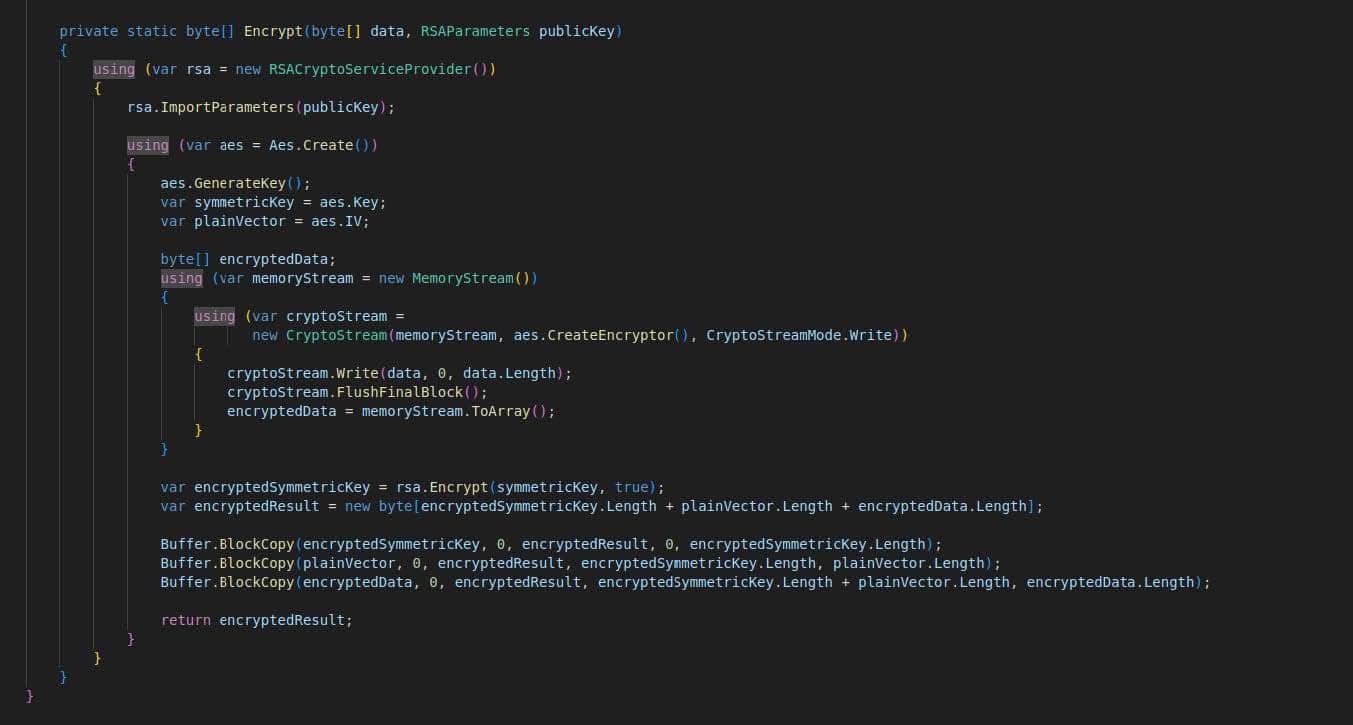
Image 5: Code from Phemedrone shows that it can successfully encrypt information using AES+RSA.
Log analysis
Based on an overlap between behavior and log format, we’ve noticed that there are variants of Phemedrone with logs sold on forums. One of those variants is a family called “Mephedrone”.
Checking our logs, we’ve noticed that we most often see Phemedrone affecting the United States, with 20% of logs attributed to that country. A full breakdown of countries can be found in the image and corresponding table below:
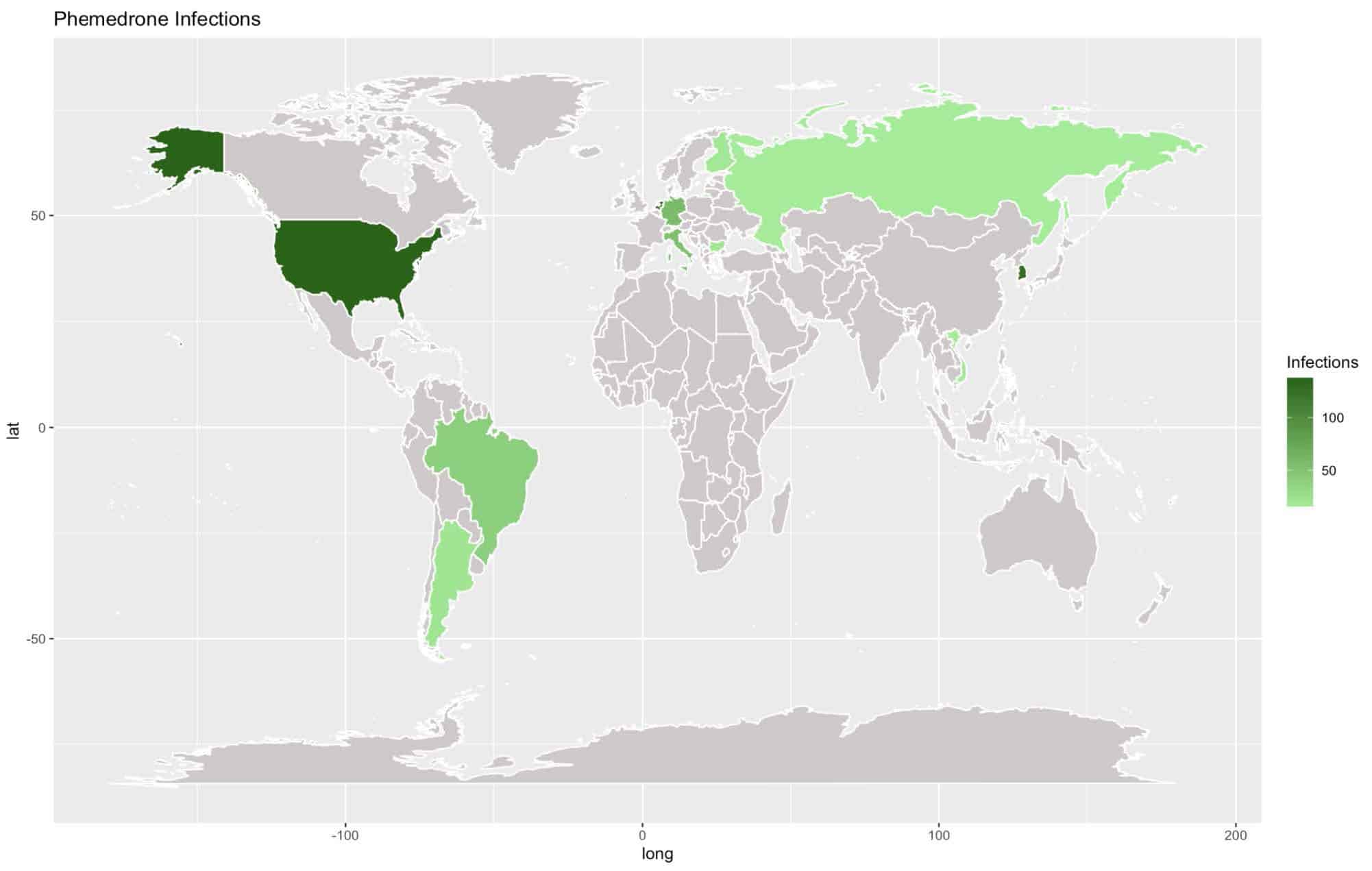
Country | Percentage |
United States | 20.00% |
Netherlands | 19.00% |
Republic of Korea | 18.58% |
Germany | 8.41% |
Italy | 7.67% |
Brazil | 5.9% |
Israel | 3.24% |
Argentina | 3.24% |
Bulgaria | 3.1% |
Finland | 2.95% |
Singapore | 2.8% |
Vietnam | 2.51% |
Russia | 2.36% |
Interestingly, Russia consisted of 2% of the total infections, despite the CIS check in the malware.
Information file
A final interesting feature of Phemedrone is that – as it parses the passwords out of its respective password stores on the victim computer (instead of on a panel) – it’s able to create snapshots in a generated Information.txt file, which allows actors to rapidly see which logs they’ve obtained. As observed in Image 6, the generated Information.txt file has a snapshot where log count can be observed:
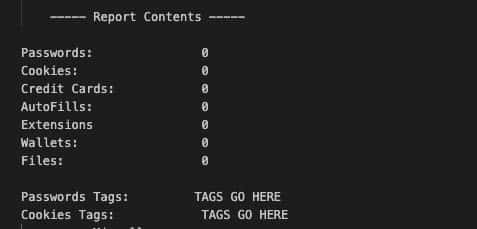
Image 6: Phemedrone’s Information.txt log snapshot, which shows what log counts can be observed.
Recap of findings
Phemedrone is an interesting case study in the evolution of infostealer families. As this article describes, there are several characteristics that make Phemedrone particularly attractive to cybercriminals:
- Phemedrone is an open source stealer that receives regular updates, making it accessible and reliable for criminals
- The stealer is highly configurable, making it flexible to bad actors’ needs
- Unlike most malware sold in Russian-langauge cybercrime groups, Phemedrone is unique in its targeting of Russian banks and other service providers
While Phemedrone appears to be used to target Russian users and services, particularly in instances where banking or financial information can be harvested, the US is still the most affected country according to our research.
Defending against Phemedrone Stealer
User exposures from Phemedrone infections (even on personal devices) can threaten businesses if actors gain access to credentials and other identity data that opens doors to your environment. We recommend security teams integrate Post-Infection Remediation steps into existing malware remediation playbooks for confirmed exposures to minimize risk and prevent follow-on attacks like account takeover and fraud.
We’ll continue to monitor developments of Phemedrone’s capabilities and review recaptured logs to better understand exfiltration trends. Keep an eye out for more reverse-engineering analyses from our team at SpyCloud Labs.
Sign up for our monthly newsletter
Get the latest cybercrime research, insights, and best practices in your inbox
